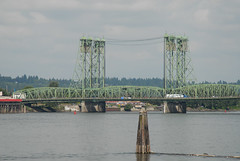
the Columbia.
(Photo © J. Maus)
We reported last week that the Bicycle Transportation Alliance has decided to resign from the the Bicycle and Pedestrian Advisory Committee for the Columbia River Crossing project.
A new post to the BTA blog by advocate Michelle Poyourow goes into detail about this decision. The post particularly outlines the BTA’s concerns about the project’s direction, its process, and their disappointment in the evolution of was once touted as a “world class” bicycle and pedestrian facility.
All members of the committee except for Poyourow voted last week to recommend an under-deck bicycle path, contingent on a strict maintenance and security agreement. Poyourow’s blog post provides a thorough analysis of the proposal’s shortcomings, including its situation under the deck, its “long, loopy, hilly,” nature, and its lack of access points. She adds that she does not believe that a strong maintenance agreement will come about, and that “there is no reason to expect this under-bridge path not to fail.”
The post states (emphasis original):
“The BTA can no longer justify pouring our members’ precious resources into a project that is bad for the health and vitality of this region and now has a lousy bike and pedestrian facility to boot.”
Poyourow told BikePortland on Friday that she believes the BTA can effectively influence the project without sitting on — and thereby tacitly endorsing — the committee.
“The problem with the CRC is it’s just been deaf to community input,” she said, adding that bicycle advocates are not the only group to have had concerns about the bridge brushed aside. “They’re not listening. They’re determined to do what they’re going to do.”
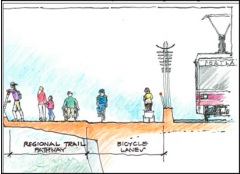
with a 6′ bike lane and 12′ path
on each side of the bridge was
recommended by the BPAC for the Three
Bridge option in June 2008
Poyourow made clear that the BTA will continue to be invested in the outcome of the CRC process. “People really want to see a great, multi-modal connection across the river,” she said, “but the CRC project has not listened to the very valid community concerns and desires for this project. We’ll be looking to support alternative processes and plans that do take these concerns and values into account.”
She said that the Coalition for a Livable Future has “provided a helpful gathering place, to share ideas about strategy and be in touch with people concerned not just about bikes.”
The BTA is deciding on its next steps beyond fully explaining its concerns to the project sponsors. Poyourow said they are actively working with other local groups to identify a viable alternative proposal that they can support, and plan to work directly with local and federal politicians, funders, and stakeholders to develop what Poyourow hopes will be “a real solution — not a false solution.”
As for the viability of the current plan on the table for the project, Poyourow said, “I don’t think what they’re proposing now will come to pass. I hope something happens. But not this.”
– See our full coverage of the Columbia River Crossing design process, funding, politics, and opposition here


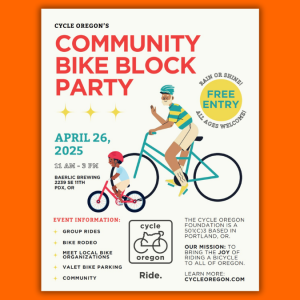

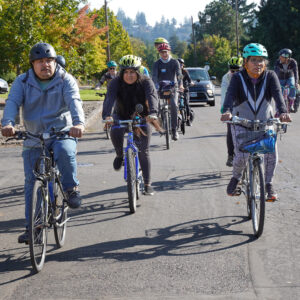
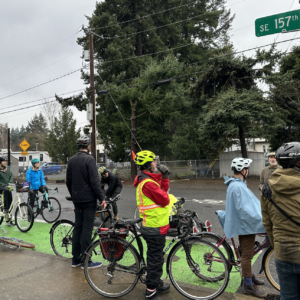
Thanks for reading.
BikePortland has served this community with independent community journalism since 2005. We rely on subscriptions from readers like you to survive. Your financial support is vital in keeping this valuable resource alive and well.
Please subscribe today to strengthen and expand our work.
I support the BTA’s recent decisions on this. Was the sketch above from them? Have they proposed an alternate solution with drawings, data, etc.? The sketch looks much more user-friendly. Being a former architect, I’d be glad to draw up any ideas they have including perhaps some sort of simple covering or canopy over the bike/ped lane.
Regardless, if this helps lead to the death of that under-deck path solution, I just might revive my BTA membership.
I noticed how Poyourow described the current design as “its “long, loopy, hilly,” nature, and its lack of access points.” If you put the bikes/peds on the top deck they are some 20 feet higher in elevation (100 feet above river). This will make for even less access and longer approaches with more loops.
Elly – please revise the text above to note that the concept drawing above was developed by the BPAC for the Three Bridge option (“Option A” – since dropped by UDAG and adopted by the CRC PSC).
Option C (path at surface level next to the taffic breakdown lane on the bridge) as currently proposed is a more conventional flush shared surface.
[See PBAC Meeting Notes of 06 May 2009 – Page 20.]
This is not to say that the general layout of Option C could not be similar [someday] to PBAC’s recommendation for Option A shown above…but at this point it is doubtful as Option C is much narrower (12′ minimum width – 1 path per side)* than either Option A (18′) or Option B (24′). It is tougher to pull off this type of facility with much less space – unless bike traffic becomes a couplet, etc.
[*Note: CRC staff research reports that the minimum ODOT/ WSDOT pathwidths are 14′ for a SUP.]
Thanks for the clarification, Todd, I edited the caption.
I had a typo above, it should have read:
“since dropped by UDAG and [not] adopted by the CRC PSC)”
I would still like to gain a better understanding of how much clout the BTA will have by walking away from this situation. Does the BTA have a concrete plan in place to circumvent a review process they referred to earlier as “theatre”? Can they muscle a new plan into being, or at least block the current plan until more support for alternatives is built? This situation remains unclear and I would like to hear some concrete proposals from the BTA.
this whole thing smells to high heaven, and speaking as a BTA member I’m glad they’ve decided not to participate in this charade. Let’s aim a small fraction of that $4.2 billion at TDM first, do some congestion pricing (gasp!!!), then reassess.
So, since the BTA has cleverly decided they’re not talking to the CRC people, how are they going to communicate their sweeping vision of utopia to the people who make design decisions?
Telepathy? Voodoo Dolls?
There’s hope yet! Let’s work for a better bridge design! I would stress that we focus on the proposed costs of this monumental bridge. What other things could we buy with $4.1 billion in the middle of a recession?
Daniel – I wish it [national infrastructure politics] worked that way for the Portland-Vancouver area. If our collective local leaders do not find a federally fundable/ score-able project then these funds pass onto the next in line. [Unless the rules change very soon.] There is not a lot of flexibility since this is not “Portland” money or “Vancouver” money but Federal funds for the most part.
Your question is a valid one but would be more like: ‘What other things could we [the next community in line for these FHWA & FTA funds] buy with $4.1 billion in the middle of a recession?’
The construction and manufacturing jobs (and federal-state-local costs/ borrowing) for this project will hit long after this current recession passes into the next boom[-bust] period.
Now if your question dealt with the $30m (OR) and $50m (WA) has set aside for the planning and design aspects of this project – then that is another issue to discuss.
I’d rather have no money than to build a massive highway project between our two cities. The miniscule light rail and bike/ped component (both tucked underneath the main highway bridges) are small tokens to multimodalism that reek of tailpipe emissions.. Exactly how wide is 12 lanes anyway? What is the width of the concrete swath of ramps, auxiliary lanes and through lanes on this multi-modal project?? I measured 600′ going through Hayden Island. Why don’t we just call this Texas and build it? Hopefully we’re not that stupid.
I applaud BTA for getting out of this mess. They’re refusal to continue participation speaks volumes about this process that favors out-of-touch highway engineers over planners, bicyclists and neighborhoods.
Hello face? I don’t love you any more, goodbye. -Nose
re Todd@#9:
> There is not a lot of flexibility since this is not “Portland” money or “Vancouver” money but Federal funds for the most part.
I was under the impression that the Feds aren’t going to be paying for the large majority of the project as they have in the past with highway projects. The fact that the feds won’t pay most of it is why there is so much talk about tolls right?
Regardless… spending *any* money on a giant sprawl-inducing monster is money spent poorly… (no matter where that money comes from!).
Anyone who’s studied public process and power politics, or has seen the spin on the CRC, knows that the CRC boosters will point to the fact that “We had a bike advisory committee” and people not paying attention will read that as “bicyclists’ concerns were heard.”
If you participate in a process for months and months and realize that your concerns are totally ignored and the process is a sham, you have a responsibility to stop providing cover for those who are looking to railroad you into a preordained conclusion.
The backers of this project are doing many things that they haven’t been sufficiently called on by the press:
– They don’t talk about real numbers and where the money is coming from. They want to create a conclusion while excluding discussion of money, as money is one of their weak points.
– They don’t talk about trade-offs or options. Again, the question of “how would you spend $4 billion in the region to best benefit it”? is simply ignored.
– They don’t provide realistic images about the project. Again, images of huge slabs of concrete with weaken support for the project. Hence the faux lighting on the under-bridge bike path, etc.
The BTA leaving signals the public that “we have been good partners, but frankly our presence is providing political cover for this boondoggle.” Kudos to them.
I am a BTA member and very happy that Ms Poyourow made the decision to quit the CRC committee. Now if only some others (on the Metro Council) would get a backbone.
I don’t want to enable single occupant vehicles and their drivers with my hard-earned money. Start charging SOVs an adequate not just token toll NOW and see if a new bridge is still needed.
007: you are correct with the need to reestablish a toll on the Columbia crossings…but what most do not understand is that Congress has made it almost impossible to place tolls (and HOV lanes) on established interstate facilities unless new capacity has been created (like what the CRC is working on).
[The last time I looked – though the Bush 43 administration was very pro toll and perhaps there are new rules on this topic.]
Peter W – you are a bit correct…the Feds no longer pay for almost all of interstate projects – they used to 90% of interstate (states covered the remaining 10%) vs. 70% of FTA projects.
For the CRC project’s mix of FTA and FHWA work I have heard there will be a mix (equal thirds?) of Federal/ State /and local [tolls]. The Federal portion of the FTWA highway work is higher than the FTA portion – that is why the system has always been ‘unfair’ to urban cities.
And the local funding will likely have to cover some of the more creative design treatments of this proposed project.
Evan –
Point 3) I think you may be using one conceptual image (lighting under a bridge) to paint the entire PBAC’s advisory process. I have not seen you at any of the 27 or so PBAC meetings I have attended. They have used a lot of our (Michelle’s and ours) design comments to make the bikeway a better facility. I think that their images of 16+ lanes covering the middle of Hayden Island – leading to all the big box retail there – has been more than fair [and perhaps too effective].
I will see what PBAC recommendations make it into the FEIS and then come to the conclusion on the process. Sadly I as a BTA member in Vancouver was looking to the BTA to be 500 lbs gorilla in the PBAC room. Who now should we look towards for leadership: the cities? the DoTs? the freight community (remember St Johns)?
[Evan…as an experienced lobbyist and friend to the BTA would you suggest to the BTA that it leave Salem when it has a bad year?]
Point 1) As for your comment about funding – yes that is a very weak link – especially for the maintenance of the light rail extension into Vancouver (going to a vote). I worry that all this project bashing will just give the anti-rail and anti-toll and anti-bike crowd up here and to your east more ammo (and leave us divided).
Point 2) About the $4B they are talking about light rail + bikes + pedestrians + tolled cars + freight. What more can they add to this mix other than a ferry, new rail bridge and perhaps a third PDX runway? I am not sure they could deviate too far from what they have proposed and get federal support and the support of two diverse bi-state communities.
NEXT STEPS
I have heard the BTA saying that they have a plan…but I as a PBAC participant and long BTA partner have not been told it…I worry how developed their strategy was between leaving the PBAC meeting and Jonathan’s interview about their withdrawal. I would have expected a few more days to give the BTA staff time to poll its biggest political supporters (some are involved in the CRC process) and board members on what move to take next .
I am still hoping for the best – for us bicyclists who cross the Columbia to and from Portland.
From what I heard from a PBAC member who watched the PSC discussion on Friday it sounded like it went better (full support for the PBAC recommendation for maintenance and security) than the reporter reports below.
Mayor Adams, I was told, seconded the motion to make the wording of the PBAC recommendation stronger than written. It passed the PSC.
———
In today’s paper there was an article updating the status of this discussion – you Portlanders may have missed it:
http://www.columbian.com/article/20090906/NEWS02/709069979/Bridge+sponsors+second+the+call+for+a+pedestrian+deck
Bridge sponsors second the call for a pedestrian deck
Discussion centers on issues of security
Saturday, September 5 | 10:35 p.m.
BY ERIK ROBINSON
COLUMBIAN STAFF WRITER
——
I work with the I-5 Columbia River Crossing (CRC) project and provide staff support to the project’s Pedestrian and Bicycle Advisory Committee. I’d like to correct some recent misinformation about plans for the pedestrian and bicycle path. First, I want to provide an update and some good news.
On Sept. 4, the CRC Project Sponsors Council unanimously supported a plan that would substantially improve bike and pedestrian access across the Columbia River, based on the recent PBAC recommendation. (You can watch the meeting on http://www.cvtv.org). The project is now moving forward with a two-structure bridge across the Columbia River that will improve travel for bicyclists, pedestrians, public transit riders, and all other users. Today, the CRC Urban Design Advisory Group adopted a design concept for the main span across the Columbia River and two alternative design concepts for the North Portland Harbor bridge.
Below are a few facts about the proposed bike and pedestrian path. You can view an image of the proposed path design on page 25 of this document: http://www.columbiarivercrossing.org/FileLibrary/MeetingMaterials/UDAG/UDAG%20Meeting%20Materials_09_18_09.pdf
Path width: The covered path on the future I-5 bridge will be up to 24 feet wide, compared to the current 4-ft wide paths.
Access points: There will be ramps, stairs, and/or elevators connecting with existing and planned sidewalks and pathways in Vancouver, on Hayden Island, and near Marine Drive. The connections will be coordinated with ongoing planning in those areas. The entire pathway, connecting ramps and all other improvements in the five-mile corridor will be compliant with the Americans with Disabilities Act.
Scenic overlooks: The project’s Urban Design Advisory Group is examining options for at least one overlook on the replacement bridge.
Sense of openness: Only about a quarter of the new path will be covered, and this portion will be open on both sides, providing light, fresh air and views. The ceiling of the covered section will be 23 to 30 feet high. The two overhangs cantilevering from the sides of the bridge above the covered pathway will be approximately 20 feet each (not 200 feet).
Distance: The proposed new path is a somewhat shorter route (2.20 miles instead of today’s 2.25 miles, measuring from Delta Park to Esther Short Park) and eliminates the current steep grade on the existing bridges. The proposed path requires fewer at-grade roadway crossings. The covered path option minimizes the distance traveled on the ramps approaching the bridge, compared to the other options, thereby reducing the amount of out-of-direction travel.
Peter Ovington
Columbia River Crossing project
ovingtonp@columbiarivercrossing.org